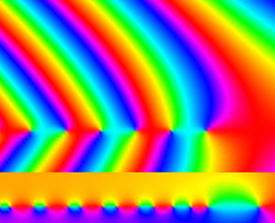
Graph showing part of the complex number phase of the gamma function and a related function. One of the most important of the "special functions" discovered in the 18th century, the gamma function is related to the more familiar factorial function and plays a role in a wide variety of applications of probability and statistics. Here the pattern resembles that of fluid flow near the end of a line of vortices.
GAITHERSBURG, Md. -- After a decade of preparation, the U.S. Commerce Department's National Institute of Standards and Technology (NIST) has released the Digital Library of Mathematical Functions (DLMF) and its printed companion, the NIST Handbook of Mathematical Functions, the much-anticipated successors to the agency's most widely cited publication of all time. These modernized reference works contain a comprehensive set of mathematical tools useful for any and all specialists who work with mathematical modeling and computation.
The works comprise a complete update and expansion of the 1964 Handbook of Mathematical Functions edited by Milton Abramowitz and Irene Stegun of NIST. That Handbook quickly became an indispensable reference for scientists and engineers who use the tools of applied mathematics in their work. While the 1964 volume has sold an estimated 1 million copies and still averages more than 1,600 citations per year in scientific papers, NIST embarked on the new work in response to advances in electronic information exchange as well as in mathematics itself.
The new 36-chapter tome is designed to be the definitive reference work on applied mathematics' "special functions," the term collectively used to describe the most important and widely employed mathematical functions. Special functions appear whenever natural phenomena are studied, engineering problems are formulated, and computer simulations are performed. They also crop up in statistics, financial models, and economic analysis.
The DLMF provides critical reference information needed to use these functions in practice, such as their precise definitions, alternative ways to represent them mathematically, illustrations of how the functions behave at extreme values, and their relationships to other functions and concepts.
"When studying a phenomenon, experts want to know more than just how to describe it qualitatively," says NIST's Dan Lozier, one of the works' editors. "They need to know its relationships to other phenomena and get insight into its behavior. For this they need mathematics. And as they progress with their research, whether it is in mathematics, science, or engineering, they want to know how to perform all the necessary mathematical analyses and computations, from conception to conclusion. The DLMF will help with all these tasks."
The new work differs from the 1964 publication in several respects. It includes information about additional special functions that have more recently come to prominence in applied mathematics, the physical sciences and engineering, as well as in other fields. It has also been subjected to a more rigorous editorial process, complete with independent validation of all technical material. Perhaps the greatest difference, however, is its transformation into a Web-based resource.
The online DLMF, freely available on the Web, includes visual aids that provide qualitative information on the behavior of mathematical functions, such as interactive tools for rotating and zooming in on three-dimensional representations. These visualizations can be explored with free browsers and plugins for PC, Mac and Linux systems. Confused about the symbols in an equation? Just click on the symbol to be led to its definition. The DLMF also provides references to or hints for the proofs of all mathematical statements, offers advice on methods for computing mathematical functions, and provides active links to available software and references. It also features a powerful search engine.
With more than 8,000 equations and nearly 500 figures, the DLMF has about twice the amount of technical material of the 1964 publication. The lengthy tables of function values that took up a great deal of the earlier work – a necessity before the advent of desktop computers – are no more, and the purely mathematical content is now much greater.
"This is a much more complete package for the user," Lozier says. "We anticipate the DLMF to be a useful resource for everyone who has benefited from the 1964 publication, and expect that it will find new audiences among biologists, data security specialists, and every other branch of science that employs computer-based models."
Compiled and extensively edited at NIST, the DLMF received initial seed money from the National Science Foundation and resulted from contributions of more than 50 subject-area experts worldwide. The NIST editors are Frank W. J. Olver, Daniel W. Lozier, Ronald F. Boisvert and Charles W. Clark.
The DLMF is available at http://dlmf.nist.gov/. Its 967-page printed companion, the NIST Handbook of Mathematical Functions (ISBN 9780521192255), is published by Cambridge University Press.

